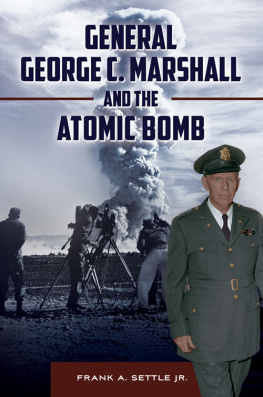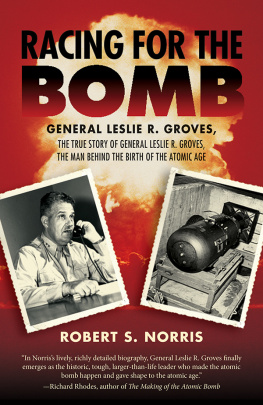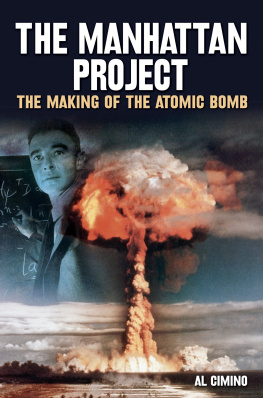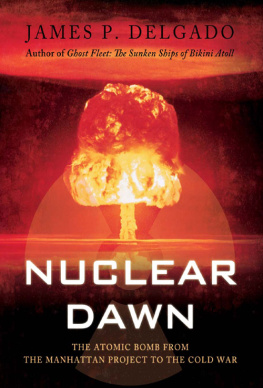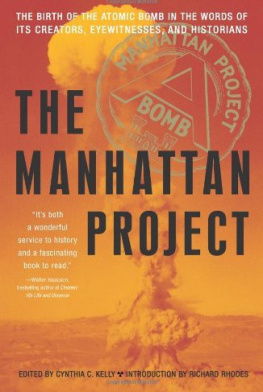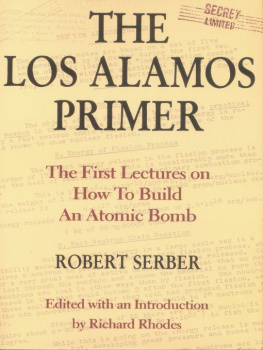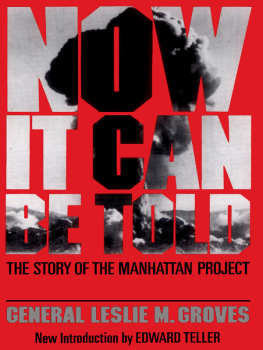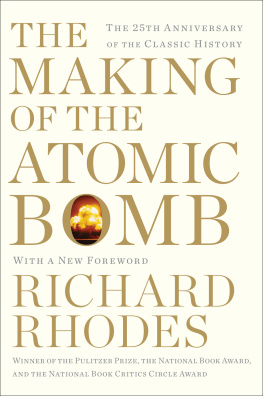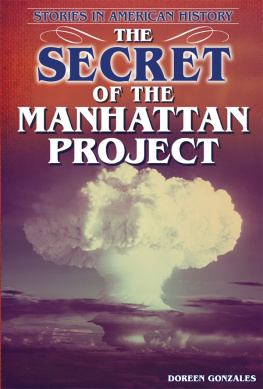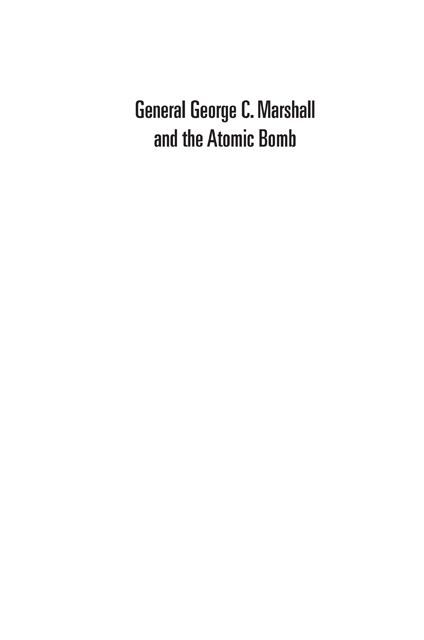
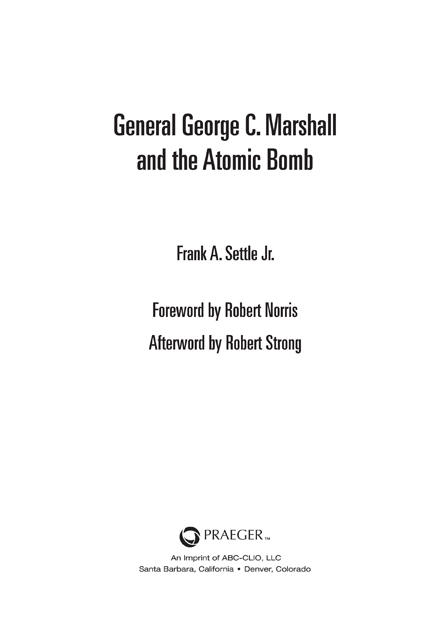
Copyright 2016 by Frank A. Settle Jr.
All rights reserved. No part of this publication may be reproduced, stored in a retrieval system, or transmitted, in any form or by any means, electronic, mechanical, photocopying, recording, or otherwise, except for the inclusion of brief quotations in a review, without prior permission in writing from the publisher.
Library of Congress Cataloging-in-Publication Data
Names: Settle, Frank A., author.
Title: General George C. Marshall and the atomic bomb / Frank A. Settle Jr.; foreword by Robert Norris ; afterword by Robert Strong.
Description: Santa Barbara, California : Praeger, 2016. | Includes bibliographical references and index.
Identifiers: LCCN 2015044504 | ISBN 9781440842849 (alk. paper) | ISBN 9781440842856 (EISBN)
Subjects: LCSH: Marshall, George C. (George Catlett), 1880-1959. | World War, 19391945Biography. | Atomic bombUnited StatesHistory. | GeneralsUnited StatesBiography. | StatesmenUnited StatesBiography. | Cabinet officersUnited StatesBiography. | United States.
ArmyBiography.
Classification: LCC E745.M37 S48 2016 | DDC 355.0092dc23 LC record available at http://lccn.loc.gov/2015044504
ISBN: 978-1-4408-4284-9
EISBN: 978-1-4408-4285-6
201918171612345
This book is also available on the World Wide Web as an eBook.
Visit www.abc-clio.com for details.
Praeger
An Imprint of ABC-CLIO, LLC
ABC-CLIO, LLC
130 Cremona Drive, P.O. Box 1911
Santa Barbara, California 93116-1911
This book is printed on acid-free paper 
Manufactured in the United States of America
To Cecile
Contents
Foreword
Much has been written about Gen. George C. Marshall and about the Manhattan Project, but these accounts provide a greater perspective on Marshalls role in the development and use of the atomic bomb during World War II, and in the post-nuclear world.
There is always room for more to be written about the Manhattan Project and about George C. Marshall. This book reveals Marshalls involvement with nuclear weapons during the first ten years of the nuclear age. Ostensibly, Army Chief of Staff Marshall and Secretary of War Henry L. Stimson were in charge of the Manhattan Project, but they trusted Gen. Leslie R. Groves, as commanding general, to make many of the major decisions and become the projects driving force.
As early as 1938, General Marshall was among those who realized that the United States would eventually have to stand up to Hitler, and that it must prepare for war. On September 1, 1939, the day Hitler invaded Poland and plunged Europe into war, Marshall took the oath of office as chief of staff of the Army. President Franklin Roosevelt chose Marshall for the job over many senior generals because he recognized talents in him that others had observed previously during Marshalls already-distinguished career. Marshall would serve the nation well for years to come.
The day before the Pearl Harbor invasion the decision was made for the Army Corps of Engineers to administer what would become the Manhattan Project, in part because placing it under the Corps would help hide the huge and costly project within the Armys budget from Congress, the public, and Americas enemies. Marshall, who already was shouldering a wide range of responsibilities, was in place to oversee the project along with Secretary of War Henry L. Stimson and Gen. Leslie R. Groves.
During the period from Pearl Harbor to June 1942, the United States made little progress on developing the bomb. The Army was directed by President Roosevelt to manage the project. That June, President Roosevelts science adviser, Vannevar Bush, was not satisfied with the Armys initial progress and asked for new leadership. As a result, in September 1942, Lt. Gen. Brehon B. Somervell and Maj. Gen. Wilhelm D. Styer chose Colonel Groves to head the Manhattan Engineer District. His selection was immediately approved by General Marshall.
Somervell gave Groves the news in a corridor of the New House Office Building (later Cannon) after Groves provided testimony on a military housing bill. Groves was not pleased with the news. Somervell told him that the secretary of war and the president had approved the selection, and thus Groves knew it was pointless to protest. His actions over the following thousand days testify that he expended every ounce of energy to make ready a weapon that would play a crucial role in the war.
General Marshall, who was quite busy overseeing the U.S. role in the war, rarely contacted Groves to learn about the status of the project. The Manhattan Project was minor compared to invading North Africa or Europe. And typically, Marshall believed that once you gave a job to a trusted, competent person, you let him do it and without interference. This was the way the secretary of war and other high government officials operated in that era, vastly different from today. Groves initiated appointments with General Marshall only a few times. One such time was to have Marshall read a report prepared for the president. At other times he did so to convey information or to secure his advice. In these cases Groves prepared a short memo written in clear English that Marshall read.
Groves duties expanded over time. In several instances, Marshall assigned Groves new responsibilities that were added to his portfolio. One example had to do with trying to discover if the Germans had an atomic program. While atomic intelligence could have been handled by other agencies such as G-2, Marshall thought it would be more secure under Groves watch. Groves took on the task and, among other things, went so far as to plan for the assassination of a leading German atomic scientists. He asked General Styer to pass along the idea to General Marshall, who replied, Tell Groves to take care of his own dirty work.
In another instance, during a conversation about the operational planning and use of the bomb, Groves suggested that an officer of the Operations Planning Division (OPD) of the General Staff be designated to deal with the issue. Marshall surprised and pleased Groves by saying that Groves should do it himself. Marshalls reasoning was that it kept those in the know to a small number and avoided any opposition or modification to use of the bomb that might have arisen had his fellow OPD chiefs been involved.
After World War II, many questions had to be addressed about the role of nuclear weapons in the nations security policy. Marshalls responses to those questions during the first years of the Cold War would have a lasting impact.
In November 1945 Marshall retired from the Army, and within weeks President Truman sent him to China to seek reconciliation between the Nationalists and the Communists. Marshall returned in January 1947, at which time Truman appointed him secretary of state. His service over the next two years was noteworthy: for the Truman Doctrine, the Marshall Plan, negotiation of the NATO pact, and for overseeing a growing U.S. nuclear arsenal. This last role became especially important after the Soviets first nuclear test detonation in August 1949.
From September 21, 1950, to September 12, 1951, Marshall served as secretary of defense. His served in that key role during a time of heavy fighting in the Korean War, which had begun in June 1950. Americas civilian and military leaders discussed the possible use of nuclear weapons during that conflict, especially after China entered the war. The question of custody and deployment of the expanding nuclear arsenal were pressing issues for Marshall, for the Joint Chiefs, and for Congress. As secretary he had to implement NSC-68, which had been issued in April 1950, to respond to the revelations of Klaus Fuchs espionage and deal with President Trumans decision to relieve Gen. Douglas MacArthur of his command.
Next page
